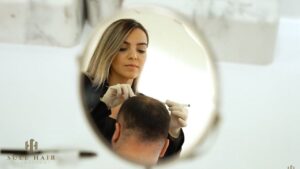Introduction
Receding hairlines and temple hair loss are common concerns among men and women experiencing hair loss. These issues can impact self-esteem and overall appearance, but fortunately, hair transplant surgery offers a solution. In this blog post, we’ll focus on hair transplant techniques specifically aimed at addressing receding hairlines and temple hair loss. By discussing the process, benefits, risks, and a helpful data table, we aim to provide you with all the information you need to make an informed decision about hair transplant surgery at Sule Clinic.
Understanding Receding Hairlines and Temple Hair Loss
Receding hairlines occur when the hair at the front of the scalp begins to thin and recede, creating a distinctive ‘M’ or ‘V’ shape. Temple hair loss is a related issue that involves hair thinning or disappearing from the temples, further exacerbating the appearance of a receding hairline. These issues can result from genetics, hormonal changes, or other factors contributing to hair loss.
Hair Transplant Techniques for Receding Hairlines and Temple Hair Loss
When it comes to addressing receding hairline and temple hair loss, both Follicular Unit Transplantation (FUT) and Follicular Unit Extraction (FUE) techniques can be employed. However, the specific approach will depend on the patient’s individual needs and the extent of their hair loss.
During your consultation at Sule Clinic, our experienced team will assess your hair loss pattern and recommend the most appropriate hair transplant technique to achieve the best results in restoring your hairline and temple area.
| Factor | FUT | FUE | DHI |
|---|---|---|---|
| Technique | Strip Harvesting | Individual Follicle Extraction | Direct Hair Implantation |
| Scarring | Linear Scar | Minimal, Dot-like Scars | Minimal, Dot-like Scars |
| Recovery Time | 2-3 Weeks | 1-2 Weeks | 1-2 Weeks |
| Number of Grafts per Session | Higher | Lower | Lower |
| Number of Sessions Required | Fewer | More | More |
| Cost | Generally Lower | Generally Higher | Generally Higher |
Designing a Natural-Looking Hairline
A critical aspect of hair transplant surgery for receding hairline and temple hair loss is the design of a natural-looking hairline. Our skilled surgeons at Sule Clinic take several factors into consideration when designing your new hairline, including your age, facial features, and the direction of your existing hair growth. This attention to detail ensures that your hairline restoration will look as natural and seamless as possible.
Post-Procedure Results and Expectations
Following a hair transplant procedure for receding hairline and temple hair loss, patients can expect a gradual improvement in the appearance of their hairline. Within a few months, the transplanted hair will begin to grow, and the full results will be visible within 12 to 18 months. It’s essential to have realistic expectations about the outcome, as the results may vary depending on the extent of hair loss and the available donor hair.
FAQ
A: A receding hairline can be caused by several factors, including genetics, hormonal changes (such as dihydrotestosterone or DHT, which affects hair follicles), ageing, and lifestyle factors such as stress, poor nutrition, and certain medications. However, the most common cause is androgenetic alopecia, male or female pattern baldness.
A: A receding hairline often begins with the hair at the front of the scalp thinning and moving backwards, forming a distinctive ‘M’ or ‘V’ shape. Thinning or balding in the temple area is also a sign of a receding hairline. If you’re concerned about your hairline, it’s best to consult with a hair loss expert for an accurate assessment.
A: A receding hairline can begin at any age, but it’s most commonly seen in men during their late teens to early twenties. In women, it typically occurs later, often after the age of 40. However, the age of onset can vary greatly and depends on factors such as genetics and hormonal changes.
A: Yes, hair transplant surgery can be an effective solution for restoring hair to receding hairlines and temple areas. Both FUT and FUE methods, as well as the DHI technique, can be used to address this type of hair loss. The best approach will depend on the individual’s needs, the extent of their hair loss, and the availability of donor hair.
A: Results from hair transplant surgery are not immediate. The transplanted hair will usually be shed within the first few weeks following the procedure. New hair growth typically begins within 3-4 months, and the full results can be seen within 12-18 months after the surgery.
A: While you cannot completely prevent a receding hairline, especially if it’s due to genetics, there are steps you can take to slow down the process. Maintaining a healthy lifestyle, including proper nutrition, regular exercise, and stress management, can help support overall hair health. Additionally, some medications such as minoxidil and finasteride may help slow down hair loss in some individuals. It’s essential to consult with a hair loss expert before starting any treatment.
A: The number of sessions required for a hair transplant depends on the extent of your hair loss, the technique used, and your individual hair characteristics. Some patients may achieve satisfactory results with just one session, while others may require multiple sessions to achieve their desired hairline. Your hair transplant surgeon will discuss the expected number of sessions during your initial consultation.
Conclusion
Restoring your hairline and addressing temple hair loss through hair transplant surgery can significantly improve your appearance and confidence. At Sule Clinic, our team of experienced professionals is dedicated to providing the best care and achieving the most natural-looking results. To learn more or schedule a consultation, contact Sule Clinic today.





